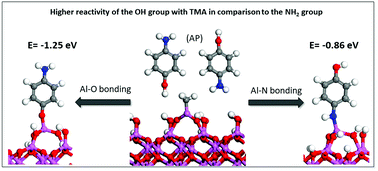Role of terminal groups in aromatic molecules on the growth of Al2O3-based hybrid materials
Abstract
Hybrid materials composed of organic and inorganic components offer the opportunity to develop interesting materials with well-controlled properties. Molecular Layer Deposition (MLD) is a suitable thin film deposition technique for the controlled growth of thin, conformal hybrid films. Despite the great interest in these materials, a detailed understanding of the atomistic mechanism of MLD film growth is still lacking. This paper presents a first principles investigation of the detailed mechanism of the growth of hybrid organic–inorganic thin films of aluminium oxide and aromatic molecules with different terminal groups deposited by MLD. We investigate the chemistry of the MLD process between the post-TMA pulse methyl-terminated Al2O3 surface and the homo- or hetero-bifunctional aromatic compounds with hydroxy (OH) and/or amino (NH2) terminal groups: hydroquinone (HQ), p-phenylenediamine (PD) and 4-aminophenol (AP). Double reactions of aromatic molecules with the alumina surface are also explored. We show that all aromatic precursor molecules bind favourably to the methyl terminated Al2O3, via formation of Al–O and Al–N bonds and CH4 elimination. While reaction energetics suggest a higher reactivity of the OH group with TMA in comparison to the NH2 group, which could enable the double reaction phenomenon for HQ, we propose that the upright configuration will be present so that the organic molecules are self-assembled in an upright configuration, which leads to thicker hybrid films. Interactions between the methyl-terminated Al2O3 with substituted phenyls are investigated to examine the influence of phenyl functionalisation on the chemistry of the terminal groups. Reaction energetics show that phenyl functionalization actually promotes an upright configuration of the molecule, which leads to thicker and more flexible films, as well as tuning the properties of the aromatic components of the hybrid films. We also investigate the interactions between methyl-terminated Al2O3 with new possible MLD organic precursors, hydroquinone bis(2-hydroxyethyl)ether and 1,1′-biphenyl-4,4′-diamine. DFT shows that both aromatic molecules react favourably with TMA and are worthy of further experimental investigation.

- This article is part of the themed collection: Spotlight Collection: Atomic and Molecular Layer Deposition


 Please wait while we load your content...
Please wait while we load your content...